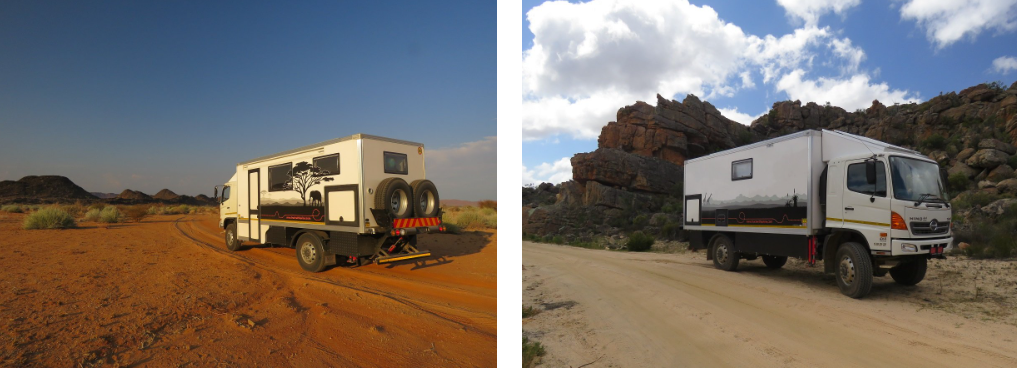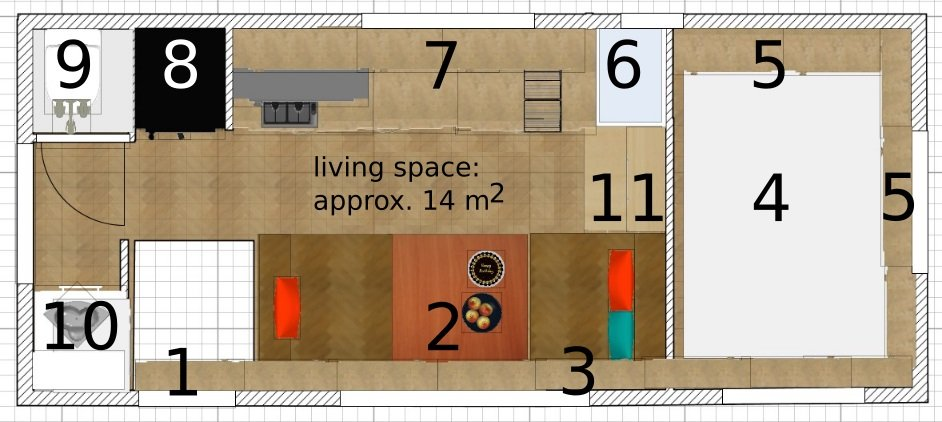So here we are! Finally on the road, with Trokkie sporting her new look with some iconic images of Africa: elephant and giraffe, aloe and thorn tree.

It’s been an interesting few months with Covid 19 Lockdown giving us time to finish Trokkie.
Turn back the clock – design time
We started playing around with the truck-travel/overlanding idea since our best friends bought their truck about six years ago. Due to many circumstances beyond our control it was only in 2019 that we came to realising this dream.
After a long search and comparing vehicles we decided on a Hino 500: a 12-ton truck with 4×4 capabilities. Yes… it’s big, but so far it hasn’t hampered us in where we wanted to go and we have a very comfortable living space and heaps of storage space.
We spent many hours “walking around” in our 3D version of the truck (Sweet Home 3d free software), just to make 100% sure that movement would be practical, while maintaining the biggest possible spacious feel that we could get. Only when we were happy with the space and flow, did Stefaan translate it into AutoCad for precise design and dimensions.
Let’s take you on a little tour around our ‘abode’.

Our house
- Entry door. We dropped that section of the truck for an easier in and out and to accommodate the washing machine (on lower floor level in position number 10)
- The dining nook is wide enough to sit four people. It is designed in such a way that the tabletop can be dropped flush with the seats (elbow grease – not electronically or hydraulically) and covered with one of the seat cushions to transform it into a full day bed/couch area. The back rest of the seat closest to the door has a little hatch that can be opened and serve as a “table” for the laptop. Nice and comfy to watch movies! Under that same seat we put our solar battery installation. The battery space is also accessible from the front door steps. The other seat houses the camping freezer that we had from before. Under the table is another storage box for odd bits and pieces. It doubles up as “wine cellar”!
- Small cupboards along the length of the truck : one can never have enough storage space.
- Queen size bed with a little “moat” all around: easier to fiddle with sheets when changing the bed linen, ample space for the duvet overflow and nice to dangle my feet off the mattress.
- Clothing wardrobes.
- Refrigerator. Originally we installed our normal home fridge, but on Trokkies Maiden Trip we did have problems with all sorts of mood swings (working – not working) so we now have invested in a proper camping fridge which is hopefully better geared up for rocky roads. Because this fridge is half size of a normal fridge, we all of a sudden have extra space on top of the fridge, for various odds and ends.
- Kitchen with 7 fairly sized drawers for anything under the sun. We cook with a microwave convection oven and an induction plate. We also installed an off the shelf cooker hood, which is a bit noisy in our tiny kitchen, but at least it keeps the excessive smells and moisture out of the truck.
- A narrower upright cabinet that houses: charging station for all our electronics, our bean-to-mug coffee machine (of course!) and again space for odds and ends. We live with the belief that eventually every nook and cranny will have its assigned “occupant”, but at the moment we’re still shoving things around as we go.
- Flushing toilet with small bathroom cabinet. A ceiling section on top of the toilet (extension of the bathroom cabinet) houses the shower head.
- Wash basin and mirror cabinet … second half of the bathroom. It can be closed with a roll door section when we shower. A door closes the toilet at all times. When this door is opened, it closes the wall sections between nr 9 and nr 10, enclosing the whole section as a shower. The washing machine is situated under the basin, but accessible from the entry steps.

Covid19 isolation
When we came back from Trokkie’s maiden trip with daughter Erika and her family visiting from Jamaica, life as we knew it shut down due to the Covid19 isolation/lock-down period (from end of March 2020). Since then we have lived in Trokkie, stationary without being able to travel: a perfect time to finish building and to see what works and what doesn’t.
In the first two/three weeks back at the workshop we were able to finish a list of things that we hadn’t been able to finish before the Jamaican family visit.
- We eventually installed the washing machine … a proper washing machine. We decided that being able to wash a decent 6kg load with proper rinsing and spinning cycle would make laundry just that much easier. It was quite a physical exercise, with just the two of us, to lift the 60kg washing machine 1M up and swing it 90 degrees to fit in a (very) tight space next to the steps.
- We exchanged the mattress which had been used on her Maiden Trip with the grand children with the permanent (queen) one. Also a logistic exercise! Only when trying to manoeuvre a mattress in this confined space do you realise how cumbersome and ungainly a mattress can be and how wide passages and spare rooms in a home make a big difference in negotiation tight bends.
- We sorted out the ‘garage’, where all our outdoorsy stuff is stored.
- We installed gas struts on the storage space under the bed. The bed weighs a few kg’s and seeing that the space under the bed is our ‘cellar’ (long term food and other stocks), we need easy access to our cellar … say once a week.
- In the first week of May when lock down in South Africa was eased from level 5 to level 4, we were able to get supplies from the hardware store and finish the cupboards running the length of the truck on the dining nook side.
- In our last month of lockdown we bit the bullet and cut a passage way between “house” and cabin. This implied cutting part of the roof of our Hino and Stefaan decided to use the opportunity to build a hatch that we can open up like a sunroof for better viewing. Access to the cabin is still a “crawl-in” rather than a “walk-in” exercise but it works. We’re keeping our fingers crossed that we’ll be fit and agile enough for years to come so that this passage keeps on being practical. (ed.note: in our recent travels in South African National Parks – Dec 2020 to April 2021- this crawl through passage and hatch has been worth gold: we can stop wherever we want in a game park, get a cup of coffee or even go to the loo, or open up the hatch and enjoy a birds eye view, about 2 m higher up than the people viewing from the SUV’s. Greta decision.
What did work well?
- Sleeping works great. As said, we have a permanent queen size mattress. We left a five cm moat around the mattress on all sides of the mattress to accommodate the spillover of the duvet. And I like to sleep with feet dangling out of bed – hence… the moat works great.
- Storage space works fine. We have wardrobes on two sides of the bed, plenty kitchen storage and other nooks and crannies where we can put stuff away: under the bed, next to the shower, under dining nook, etc.
- Cooking works fine. This lock down period allowed us to figure out exactly how the cooking works best … which appliances can be used at the same time, which ones don’t. It also made us rethink what we really use and what not. We must have had a pretty good idea, because we’ve removed only a few items.
- Our solar installation works great: plenty of sunshine in South Africa! We also can plug in to shore power on regular campsites. We did install a diesel generator but eventually decided that’s not gonna work for us: it’s seriously heavy and it makes a hell of a noise. I cannot imagine us using it at any campsite we have been to. So we tossed it. (sold it on gumtree) We’re still looking into an alternator of sorts (to replace the loud, big, cumbersome, smelly generator) to enable us to charge the battery while driving and when there might not have been sun enough to charge on solar on a rainy day. (Our truck runs on 220 volt)
- Our dining nook cum lounge suite works great. (See description above) Originally it seemed like a lot of PT to make the transformation every night, but because it cramped our legs and knees when we left the table top up, we decided one day … “let’s give it a try … after all … that was the initial idea in any case!” It quickly became part of the evening routine: dishes and cleaning up, installing the day bed and watching Netflix. (Since travelling our routine has changed a bit and most evenings we prefer to grab a book and read in bed)
- We used expanded foam panels to build the inside furniture. The best decision ever! We have had one or two serious leaks and we’re convinced that – if we would have used ply or any other wood – we would have had to redo big parts of our inside.
- Our toilet works great. We decided that we needed a proper flush toilet. Stefaans intestinal workings wouldn’t work well with a chemical toilet. Unfortunately it means carrying around more water and having an extra black water tank, but we felt it worth our while.
What needed a re-think?
- Shower… not so great. Ok, let’s rephrase that… the shower works great and the shower space is spacious. It’s just the drainage that we battled with. Initially we had a wooden duckboard for the shower so the level would be flush with the rest of our house. We kept in mind that this little floor section would be the walk through between cabin and house. The dropped space under the duckboard would be the draining space. But- BIG but- the truck is not always perfectly horizontal which means that more often than not the water runs to the opposite side of where the drain hole is. Add to that the fact that the duckboard – seeing that it needs to double up as a thoroughfare surface – was made with fairly narrow slots between the planks, the water didn’t drain quick enough between the planks. Result: water puddling up in places where we didn’t want puddles. So we decided to take that whole shower floor (and slightly raised toilet section) out and tile the whole floor section with appropriate draining holes. All done now and it works great.
- Our steps were a headache for quite a while. Because our entry door is dropped, the use of electric steps became problematic. The dimensions of a 3-step electric fold-out step would interfere with the 4×4 ground clearance we have. Stefaan went through the process of designing and building a custom-made fold out step system, but we just couldn’t get it right. Eventually we decided to can the whole idea and fixed proper steps inside the truck and use a cheapie plastic two-step stool to set outside when we are stationary. That was the easiest and most practical solution and it works like a charm!
Since traveling we have realised how different it is to be stationary at a workshop with the possibilities to still use the toilets and get enough water, it’s another thing altogether to be completely self sufficient and off grid on the road.
Enjoy the ride with us!
For more photos, clips and videos follow us on


Our home on wheels